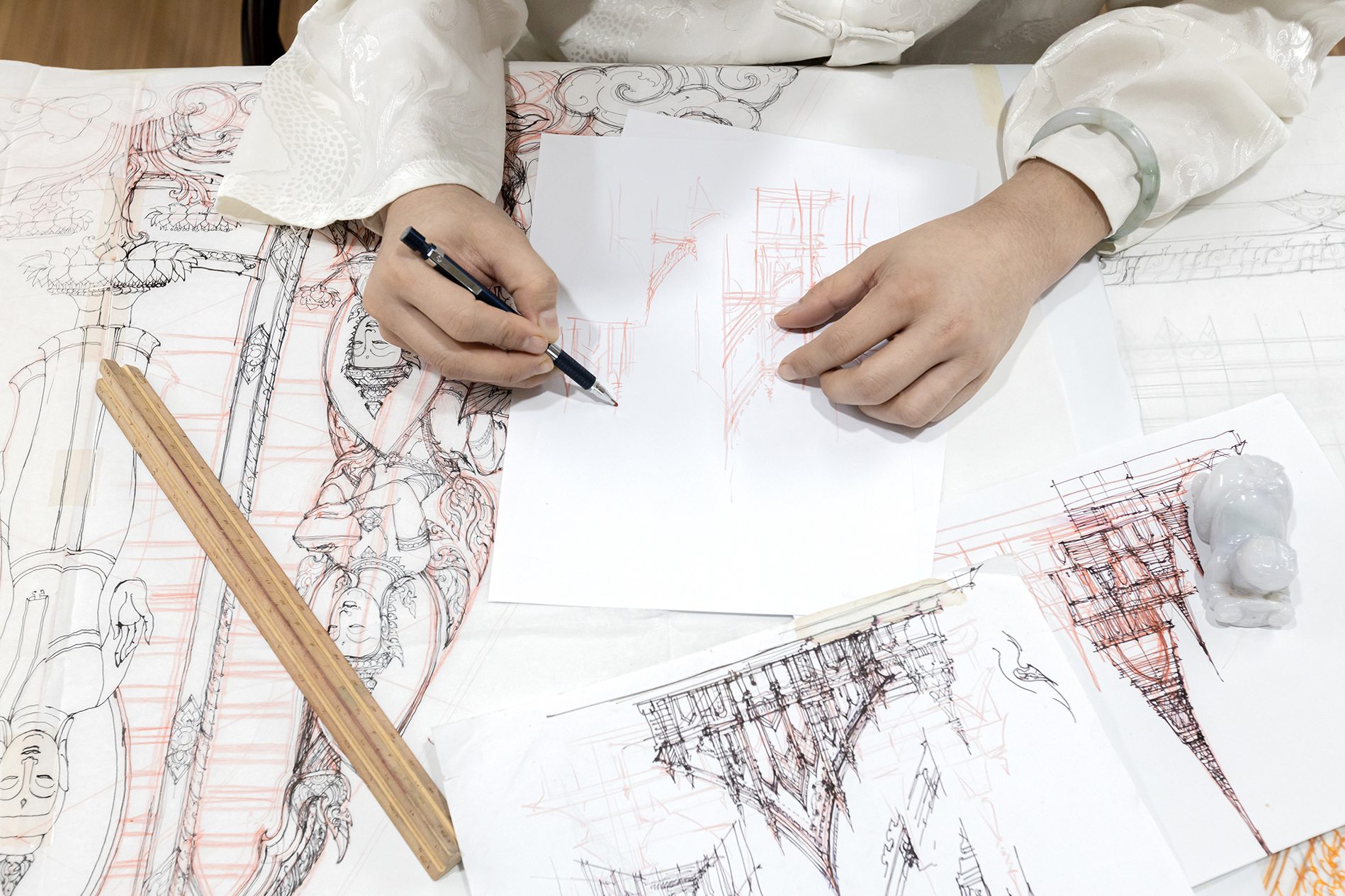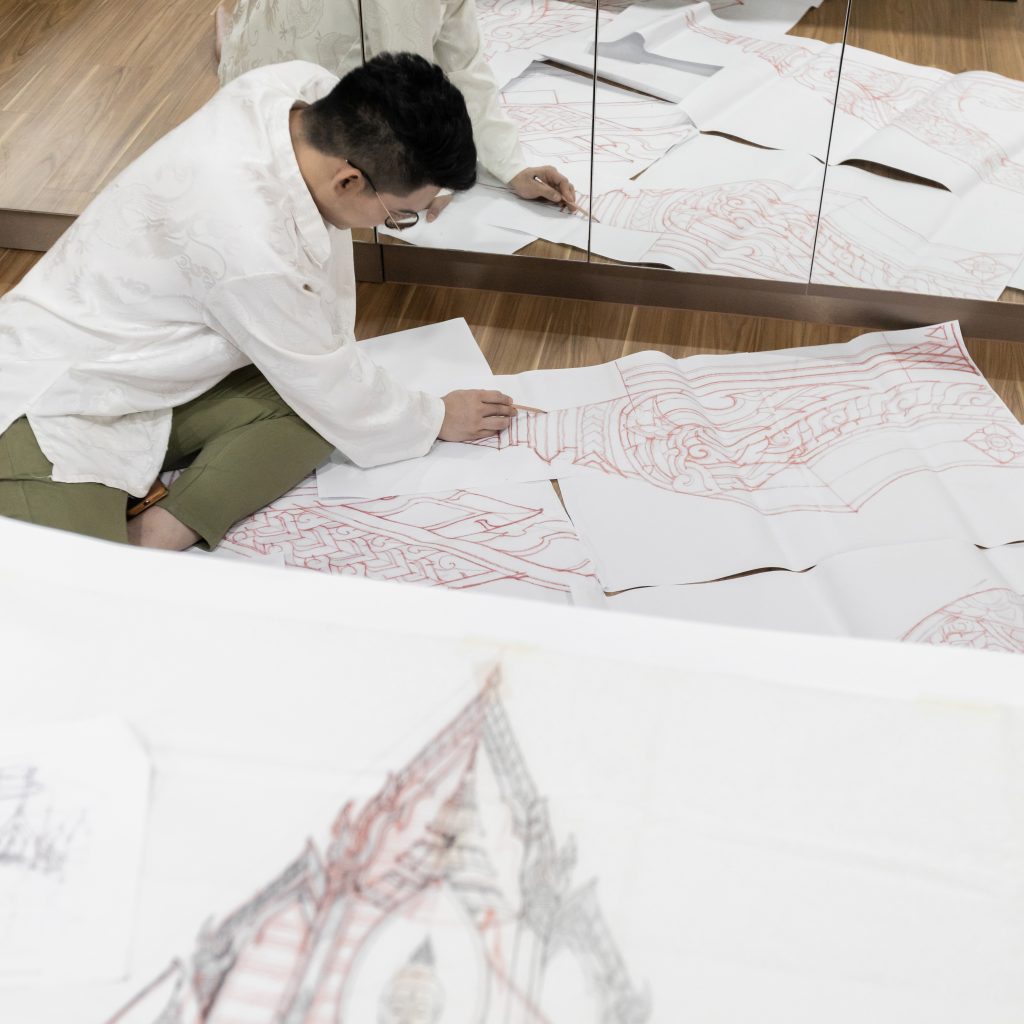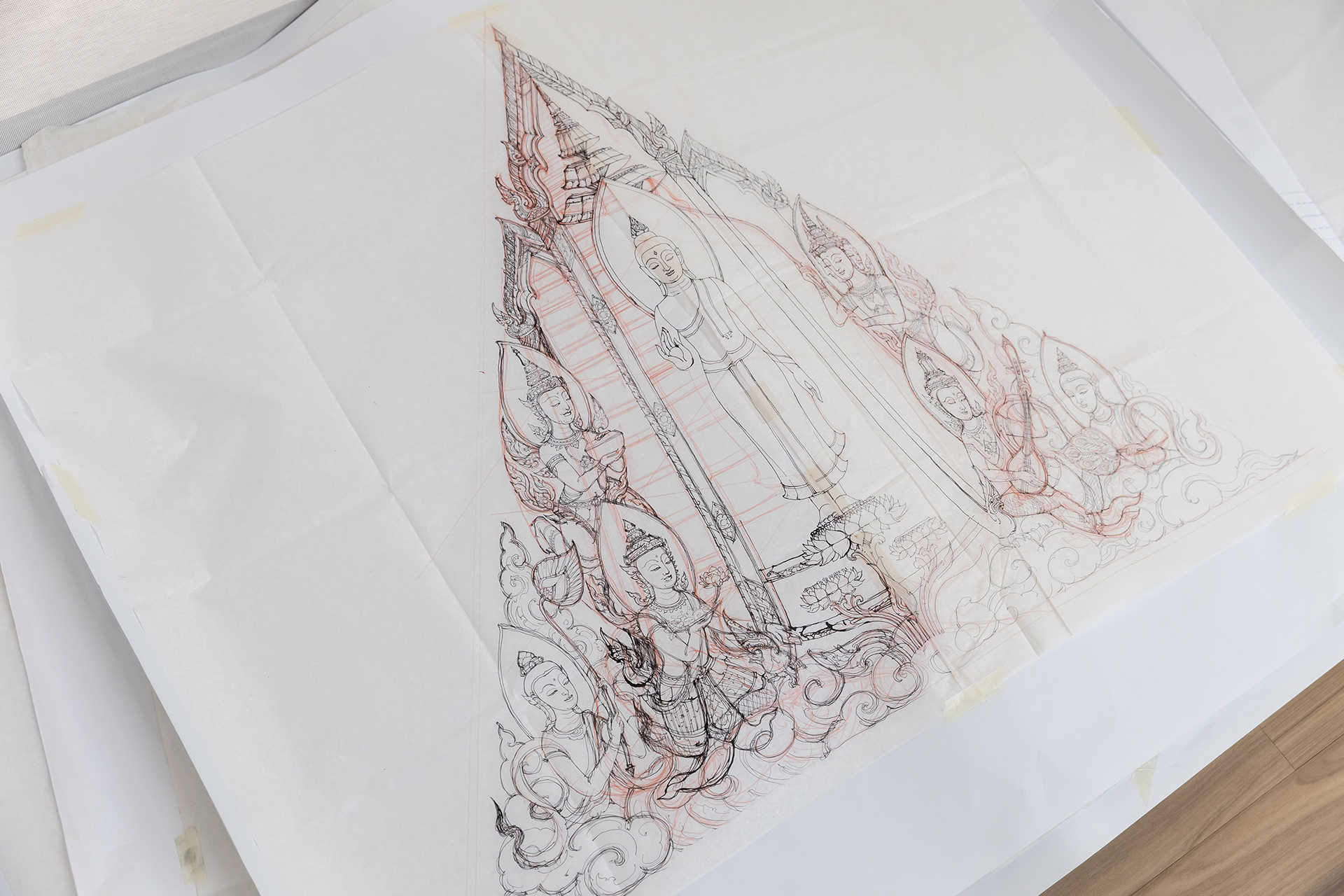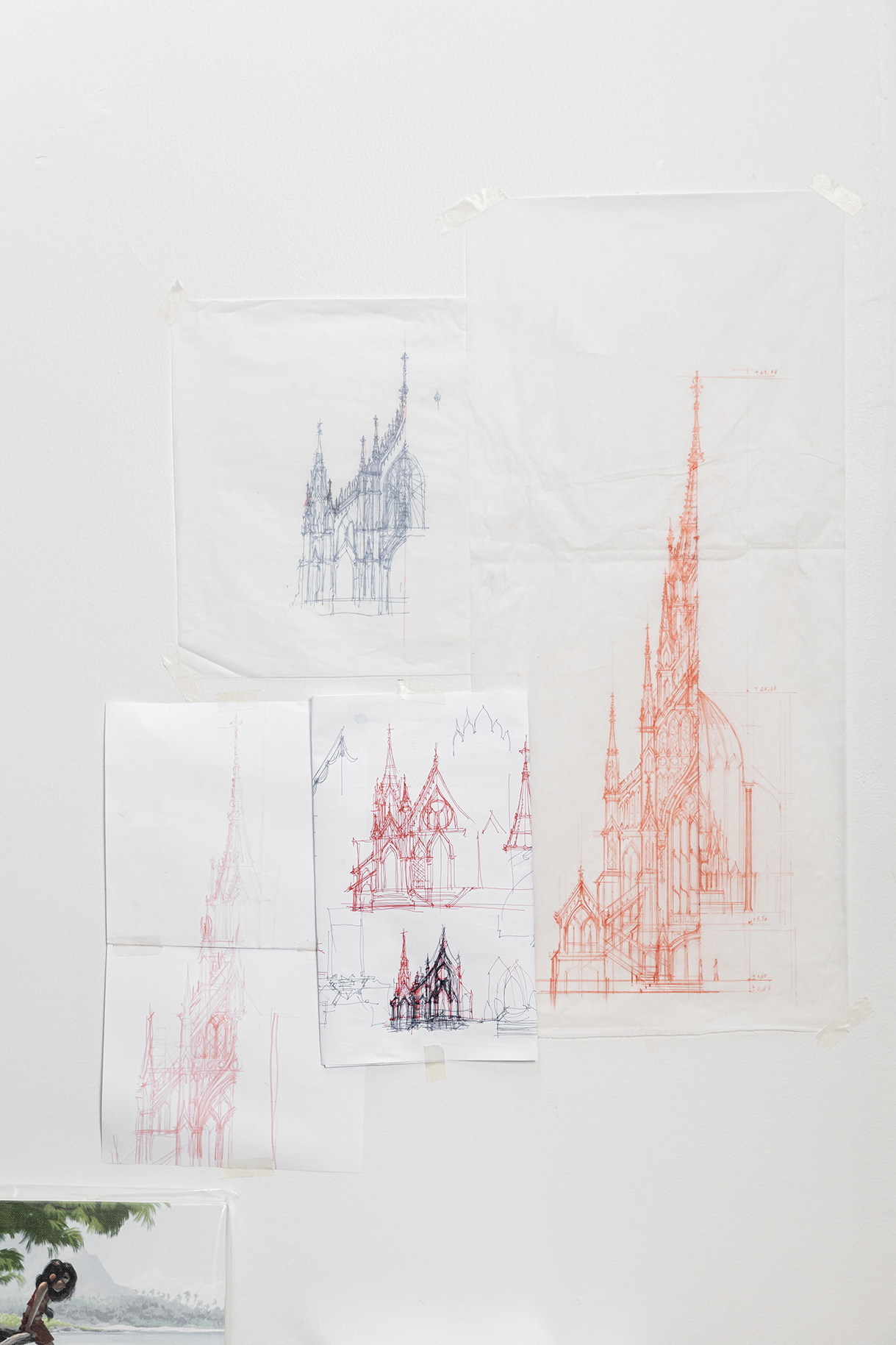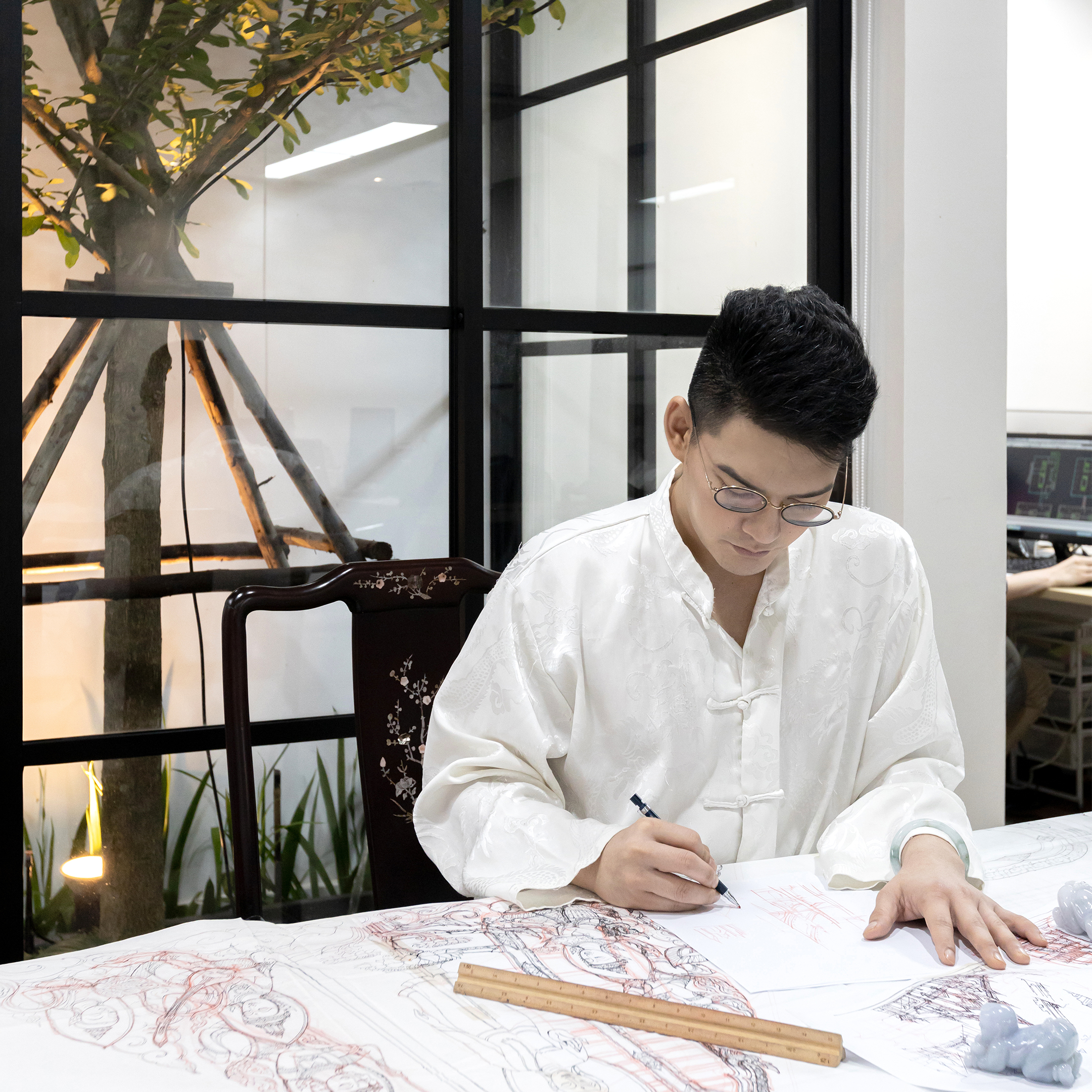A STORY OF THE ARCHITECT WHO BELIEVES THAT TRADITIONAL THAI ARCHITECTURE WILL ALWAYS FIND ITS WAY TO COEXIST WITH THE CONTEMPORARY
TEXT: PAPHOP KERDSUP
PORTRAIT: KETSIREE WONGWAN
PHOTO CREDIT AS NOTED
(For English, please scroll down)
“จำลองห้วงแห่งจักรวาล ประดิษฐานใต้ดุมล้อรถม้า
แห่งพระสุริยะเทพเทวา ผู้จรมาชั่วนิจนิรันดร์กาล
ผืนน้ำที่โค้งไปตามทรง คือผืนองค์พิภพปาฏิหาริย์
อรุณาสารถีอัศวบาล เทียมทะยาน ณ รุ่งสุรีย์
องค์ประธานห้วงอนันตกาล จักรวาลโคจรรอบรัศมี
สุริยงค์ทรงองค์แสงอัญมณี ด้วยแสงแห่งจักรราศีบริวาร”
หลายคนคงจะแปลกใจว่าทำไมอยู่ดีๆ เราถึงเริ่มต้นเปิดบทความครั้งนี้มาด้วยกลอนแปด ด้วยบทประพันธ์ที่ดูยังไงก็ขัดกับบุคลิกของ art4d โดยสิ้นเชิง แต่ถ้าบอกว่าสถาปนิกที่เราอยากจะชวนทุกคนให้ได้ทำความรู้จักกันในครั้งนี้เป็นคนที่เชื่อว่า “สถาปัตยกรรมไทย” ยังไงก็ไม่ตาย และจะยังคงมีที่ทางของมันต่อไปได้อีกเรื่อยๆ ด้วยการปรับตัวเข้ากับปัจจุบัน บทกลอนที่ถูกใช้บรรยายประกอบแนวคิดในการออกแบบอาคาร ‘ศาลาดนตรีสุริยเทพ’ ของมหาวิทยาลัยรังสิต ที่ ณัฐกฤต สุนทรีรัตน์ เป็นหนึ่งในคนที่มีส่วนร่วมสร้างสรรค์ให้เกิดขึ้นมาดูจะสะท้อนทั้งตัวตน ความสามารถ และ “ความเป็นไทย” ที่เขามีอยู่ในตัวได้ชัดเจนที่สุด
“ผมชอบแต่งกลอนมาตั้งแต่เด็ก เป็นตัวแทนไปแข่งกลอนของโรงเรียนตั้งแต่สมัยมัธยม อย่างกลอนนี้ผมก็แต่งเองจากการตีความสิ่งที่ ดร.อาทิตย์ อุไรรัตน์ และมหาวิทยาลัยรังสิตกำลังมองหา คือพออธิบายความคิดเราด้วยกลอนนี้ในที่ประชุม กลายเป็นว่าสิ่งที่เราอยากจะนำเสนอมันก็เข้าไปนั่งอยู่ในใจเขาเรียบร้อยแล้ว สิ่งที่ผมทำมันเลยกลายเป็นการทำให้สถาปัตยกรรมมันเป็นได้มากกว่าความสวยงามที่เรารับรู้มันด้วยสายตา งานชิ้นนี้มันเลยไม่ใช่แค่การออกแบบสถาปัตยกรรม แต่มันคือการสร้างอัตลักษณ์บางอย่างขึ้นมา ให้มันได้ ‘สำแดง’ ตัวออกมาจากเรื่องราวของมหาวิทยาลัยเองเพื่อให้ผู้ใช้สามารถยึดโยงตัวเองเข้ากับอาคารหลังนั้น กับพื้นที่ตรงนั้นได้”
จากเด็กห้องกุหลาบเพชร ของโรงเรียนสวนกุหลาบวิทยาลัย ห้องคิงที่ขึ้นชื่อเรื่องการผลิตนักเรียนหัวกะทิป้อนเข้าสู่แวดวงต่างๆ มาอย่างยาวนาน (แน่นอนว่าส่วนใหญ่คือสายวิทยาศาสตร์) ณัฐกฤตเล่าว่าความสนใจในศิลปะและสถาปัตยกรรมไทยของเขาเริ่มต้นจากการลงเรียนวิชาเลือกเสรีอย่างจิตรกรรมไทย “ตอนนั้นได้อาจารย์ วิศิษฐ์ เหมือนใจ เป็นผู้สอน คือท่านถือเป็นครูสอนลายไทยคนแรกของผมเลยนะ เห็นท่านเขียนลายพุดตานแล้วประทับใจมาก อยากเขียนได้บ้าง ท่านก็คงเห็นว่าเราอินกับอะไรแบบนี้ก็จะหารูปมาให้เราได้ฝึก คอยแนะนำว่าควรศึกษาตามครูท่านไหน” ด้วยความอินในงานจิตรกรรมไทยในตอนนั้น ทำให้เวลาว่างส่วนใหญ่ถ้าไม่ใช่การฝึกลอกลายตามหนังสือที่ครูแนะนำ ก็คือหมดไปกับการไปนั่งวาดรูปอยู่เงียบๆ คนเดียวตามวัดต่างๆ จนเมื่อถึงเวลาที่ต้องเลือกเรียนต่อมหาวิทยาลัย ณัฐกฤตซึ่งดูจะเป็นเด็กคนเดียวที่แตกแถวไปจากเพื่อนคนอื่นๆ ในห้อง ก็ตัดสินใจสอบทุนรัฐบาลไทย โครงการสถาปัตยานุรักษ์ เข้าเรียนสาขาวิชาสถาปัตยกรรมไทย ที่คณะสถาปัตยกรรมศาสตร์ จุฬาลงกรณ์มหาวิทยาลัย
“ตอนแรกเราก็คิดว่าเราเก่งพอแล้ว สอบเข้าได้ที่หนึ่ง ช่วงว่างๆ ก่อนเข้ามหาวิทยาลัยก็ไปหัดเขียนรูปกับพี่ๆ ช่างเขียนที่วัดตรีทศเทพ เป็นงานจิตรกรรมไทยสกุลช่าง อาจารย์จักรพันธุ์ โปษยกฤต ศิลปินแห่งชาติ ซึ่งเราถือท่านเป็นครู ผลงานของท่านส่งอิทธิพลต่อจิตใจของเรามากจนถึงปัจจุบัน ตอนเมื่อแรกเริ่มได้เข้าไปเจอกับความรู้ทางสถาปัตยกรรมไทยที่จุฬาฯ ได้เจอกับอาจารย์ผู้ใหญ่หลายๆ ท่าน ก็ต้องเริ่มใหม่หมด ระบบความคิดก็ต้องเรียนรู้ใหม่” ณัฐกฤตเล่าว่าสิ่งแรกที่เขาได้พบเมื่อเข้าไปเรียนคืองานสถาปัตยกรรมไทยนั้น “สำแดงตัว” ต่างไปจากงานจิตรกรรมไทยอยู่พอสมควร ถึงอย่างนั้น การเรียนสถาปัตยกรรมไทยที่จุฬาลงกรณ์มหาวิทยาลัยนี้เอง ที่ทำให้ณัฐกฤตได้ “ฝากตัวเป็นศิษย์” กับบรมครูทางสถาปัตยกรรมมากมาย ตั้งแต่ศิลปินแห่งชาติสาขาศิลปสถาปัตยกรรมอย่าง รศ.ดร.ภิญโญ สุวรรณคีรี พล.อ.ต.ศาตราภิชาน อาวุธ เงินชูกลิ่น และเผ่า สุวรรณศักดิ์ศรี หรือแม้แต่ ศาสตราจารย์กิตติคุณ ม.ร.ว.แน่งน้อย ศักดิ์ศรี นักวิจัยดีเด่นแห่งชาติผู้บุกเบิกงานวิจัยสถาปัตยกรรมสมัยรัตนโกสินทร์ ความท้าทายในการเรียนและทำงานสถาปัตยกรรมไทย ที่ต้องอาศัยทั้งวิชาความรู้และทักษะฝีมือ ทำให้เขามองว่ามันต้องอาศัย “ความรักแบบไม่มีเหตุผล” ถึงจะทำงานที่ยากนี้ได้ และเพื่อที่จะพาวิชาของครูบาอาจารย์ให้ก้าวพ้นไปจากคำดูถูกของผู้คน
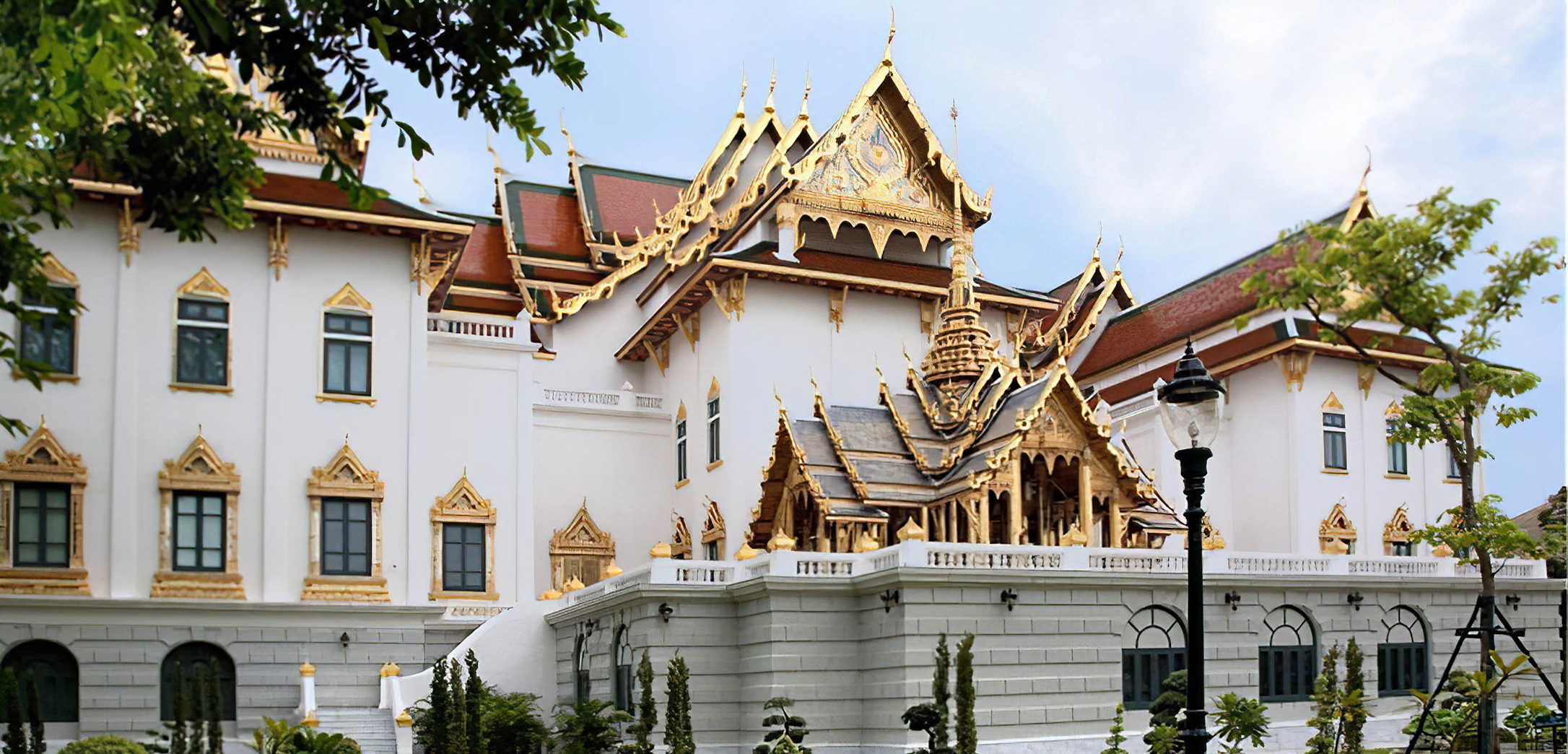
PHOTO COURTESY OF BUREAU OF THE ROYAL HOUSEHOLD
พระที่นั่งบรมราชสถิตยมโหฬาร (หลัง) และพระที่นั่งเทวารัณยสถาน (หน้า) ซึ่งณัฐกฤตได้มีส่วนร่วมช่วยทำงานหลังเรียนจบ
BOROM RAJSATHIT MAHOLARN THRONE HALL (BACK) AND DEVARANYASATHAN ROYAL PAVILION (FRONT) THAT SUNTHAREERAT WAS A PART OF THE DESIGN TEAM AFTER GRADUATION
หลังเรียนจบได้ไม่นาน สำนักพระราชวังได้มีโครงการก่อสร้างพระที่นั่งองค์ใหม่ขึ้นภายในพระบรมมหาราชวัง คือพระที่นั่งบรมราชสถิตยมโหฬาร เพื่อใช้เป็นที่พระราชทานเลี้ยงพระกระยาหารค่ำแด่สมเด็จพระราชาธิบดีและสมเด็จพระราชินีต่างประเทศ รวมทั้งบุคคลสำาคัญระดับนานาชาติ เนื่องในงานฉลองสิริราชสมบัติครบ 60 ปี ของพระบาทสมเด็จบรมชนกาธิเบศร พระมหาภูมิพลอดุลยเดชมหาราช บรมนาถบพิตร โดยในครั้งนั้นเองที่ณัฐกฤตได้รับโอกาสให้เข้าไปเป็นส่วนเล็กๆ ส่วนหนึ่งของทีมออกแบบภายในให้กับพระที่นั่งฯ ซึ่งเขาเล่าว่าต้องทำการบ้านอย่างหนักเพื่อแสดงให้ทุกคนเห็นว่า เด็กสถาปัตยกรรมไทยคนนี้ก็สามารถทำอินทีเรียแบบฝรั่งได้ ภายหลังจากงานดังกล่าว ณัฐกฤตได้รับโอกาสเข้าไปทำงานเป็นผู้ช่วยของก่อเกียรติ ทองผุด นายช่างศิลปกรรม ประจำกรมศิลปากร (ซึ่งได้ชื่อว่าเป็นมือขวาของ พล.อ.ต.อาวุธ) ในการขยายลายของพระที่นั่งเทวารัณยสถาน ซึ่งถือเป็นประสบการณ์ที่ทำให้เขาได้ฝึกปรือทั้งวิชาความรู้และฝีมือในการทำงานสถาปัตยกรรมไทยประเพณี
จุดเปลี่ยนสำคัญของณัฐกฤตหลังจากนั้นคือการได้รับทุน Tadao Ando เป็นตัวแทนสถาปนิกไทยไปนำเสนอผลงานและฝึกงานที่ประเทศญี่ปุ่น ซึ่งเพราะการได้เดินทางออกไปเจอกับโลกภายนอก กับวัฒนธรรมญี่ปุ่นที่เคารพในทักษะฝีมือช่างและงานหัตถศิลป์ครั้งนั้นเอง ที่ทำให้ตัวของเขาเองเลิก “เฟล” อยู่กับการคิดว่างานไทยจะไปต่อไม่ได้ “ผมว่าบ้านเราแปลกอยู่อย่างหนึ่งตรงที่ชอบดูแคลนคนที่มีความรู้ในศิลปะประจำชาติ คืออย่างตอนนี้เราอยู่ในยุคที่ทุกคนรู้ว่างานไทยมันยากและมีคุณค่ามากๆ คนเริ่มเห็นแล้วว่า ‘เออ มันเจ๋งว่ะ’ แต่เมื่อสิบกว่าปีก่อนนี้ดูถูกดูแคลนกันสนุกปากกว่าสมัยนี้มาก ในขณะที่วัฒนธรรมของญี่ปุ่นเขาเคารพงานตรงนี้มาก จนผมเองยังแอบรู้สึกว่าไม่เคยได้รับการเคารพเท่านี้มาก่อนเลย การได้ไปทุน Ando ครั้งนั้นเลยทำให้ได้กลับมาภูมิใจในสกิลมือของเราอีกครั้ง”
สิ่งที่เรามักพบได้ในผลงานของณัฐกฤต นอกจากการเล่นกับมิติของแสงเงาอย่างเข้าใจ ซึ่งถือเป็นการดึงคุณลักษณะพิเศษของงานสถาปัตยกรรมไทยมาใช้ได้อย่างน่าสนใจแล้ว คือการพาให้สถาปัตยกรรมไทยประเพณีมาอยู่ในงานสมัยใหม่ได้อย่างไม่เคอะเขิน ณัฐกฤตเล่าว่า งานสถาปัตยกรรมสมัยใหม่ในบ้านเราไม่ค่อยจะให้พื้นที่กับสถาปัตยกรรมไทยได้เป็น “พระเอก” สักเท่าไร สังเกตได้จากบรรดาศาลาไทยที่ไปประดับอยู่ตามที่ต่างๆ ที่หากออกแบบมาได้ไม่ดีพอแล้วจะดูไม่ต่างอะไรจากของประดับสวนเลย การจะทำให้สถาปัตยกรรมไทยเกิดบทสนทนากับสถาปัตยกรรมสมัยใหม่ได้อย่างมีลีลานั้น สถาปนิกต้องรู้ว่าอะไรคือสิ่งที่ควรหรือไม่ควรเน้น ในผลงาน สุวรรณมณฑปพระศรีศาสดา ประจำมหาวิทยาลัยรังสิต ซึ่งตั้งอยู่หน้าอาคารพิฆเนศ Student Center คือตัวอย่างที่แสดงให้เห็นทั้งกระบวนการคิดและออกแบบของณัฐกฤตที่ใส่ลงไปในรายละเอียดทางสถาปัตยกรรมไทย จนถึงการเล่นกับเอฟเฟ็กต์ของแสงและเงาเพื่อเน้นให้งานไทยประเพณีนั้นได้กลับมาเป็น “พระเอก” อีกครั้ง “ถ้าเราเข้าใจว่างานสมัยใหม่ทำงานอย่างไร งานโบราณทำงานอย่างไร เราก็จะสามารถหาทางนำพาทั้งสองสิ่งมาอยู่ร่วมกันได้” ณัฐกฤตกล่าว
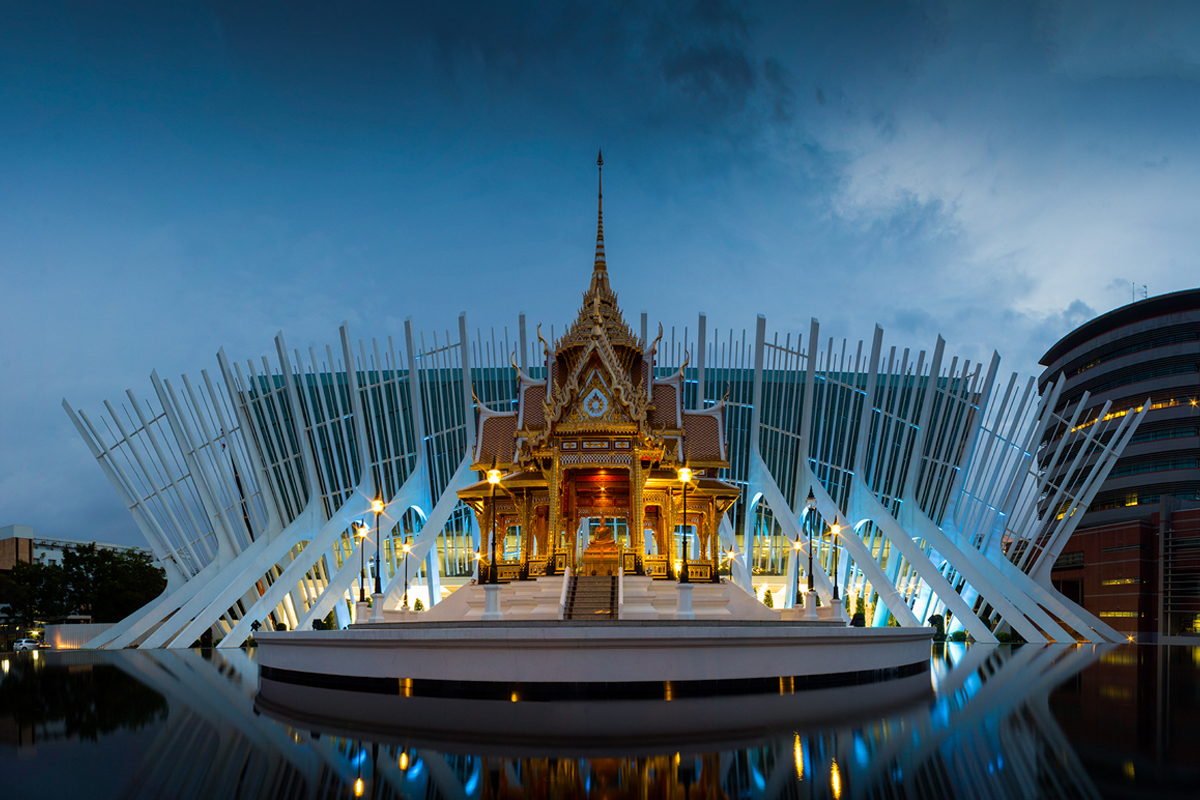
PHOTO: SOMPORN SAKKARA
สุวรรณมณฑปพระศรีศาสดา โดยมีอาคารพิฆเนศ Student Center ของมหาวิทยาลัยรังสิตเป็นฉากหลัง
SUVARNA MONDOP PHRA SRI SATSADA BUDDHA HALL WITH RANGSIT UNIVERSITY’S PIC-GANESHA STUDENT CENTER AS ITS BACKGROUND
นอกจากงานออกแบบสถาปัตยกรรมให้กับศาสนสถานต่างๆ ทั้งในประเทศไทยและต่างประเทศ (ซึ่งก็มีทั้งที่ออกแบบให้เลยฟรีๆ และตามกำลังของสถานที่นั้นๆ) หรือการร่วมเป็นทีมออกแบบโรงพยาบาลให้กับหน่วยงานต่างๆ ซึ่งถือเป็นอีกแกนหนึ่งของ Pillar Architects & Associates ที่ดูอย่างไรก็ต้องใช้เนื้อที่อีกหนึ่งบทความเลยจึงจะเล่ารายละเอียดของการทำงานส่วนนั้นได้หมด อีกหนึ่งบทบาทสำคัญที่ณัฐกฤตเพิ่งจะประสบความสำเร็จไปหมาดๆ คือการเป็นหนึ่งในทีมที่ปรึกษาด้านวัฒนธรรมให้กับ ICONSIAM ที่เพิ่งจะได้รับรางวัล Best Store Design of the Year จาก World Retail Awards 2019 และร่วมเนรมิตโครงการ ‘สุขสยาม’ ขึ้นมา ซึ่งถือเป็นการออกแบบที่รวมเอารูปแบบสถาปัตยกรรมไทยทุกภาคมาไว้ร่วมกัน โดย ‘ศาลาไทยทองคำ’ บริเวณทางเข้าเป็นไฮไลท์ที่โชว์ความสามารถในการนำเสนอทักษะเชิงช่างแบบไทยประเพณีให้รวมเข้าได้อย่างลงตัวกับวัฒนธรรมร่วมสมัย ที่ซึ่งการออกแบบสถาปัตยกรรมและตกแต่งภายในกลายมาเป็นอีกกลไกสำคัญของการสร้างประสบการณ์ในห้างสรรพสินค้า “ผมโตมาท่ามกลางสภาพแวดล้อมของ ‘ช่าง’ ตั้งแต่เด็ก อย่างแม่ผมเป็นช่างทำผม พ่อผมเป็นช่างซ่อม คุณตาเองว่างๆ ก็ไปขุดรากไม้มาฟอกสีแล้วก็แกะสลักเล่น คือผมเชื่อว่าพวกเราทุกคนเกิดมาในบ้านของช่างบางอย่างกันอยู่แล้ว ทุกคนต่างก็มีความเป็น ‘ช่าง’ อยู่ในตัวกันหมด อยู่ที่ว่าเราจะค้นพบและผลักดันมันให้ไปได้ไกลแค่ไหน”

“The vastness of the heavenly body that is the world,
Recreated underneath the carriage of the sun,
The god of light,
Eternally radiating,
The serpentine waterways,
Stretch their presence on the magically created land,
The horse-ridden god,
Rises at the coming of dawn,
Shining in perpetuity,
At center of the revolving planet,
Endlessly beaming,
Beautifully adorned with the gleaming lights of its loyal constellations.”
You’d be probably surprised to see an art4d article that starts off with a poem. But this architect we want to introduce you to is someone who believes in the immortality of ‘Thai Architecture’ and that through adaptation, the discipline can continue to evolve in the future that lies ahead. The poem is a rough translation of a Thai octameter poem that is used to describe the design concept of Rangsit University’s ‘Suryadhep Music Sala,’ which has Nathakrit Sunthareerat, the architect whose thoughts we are sharing with you in this very article, as one of the creators. It also somehow perfectly encapsulates the architect’s identity, abilities and the manifestation of the Thai spirit running through his veins.
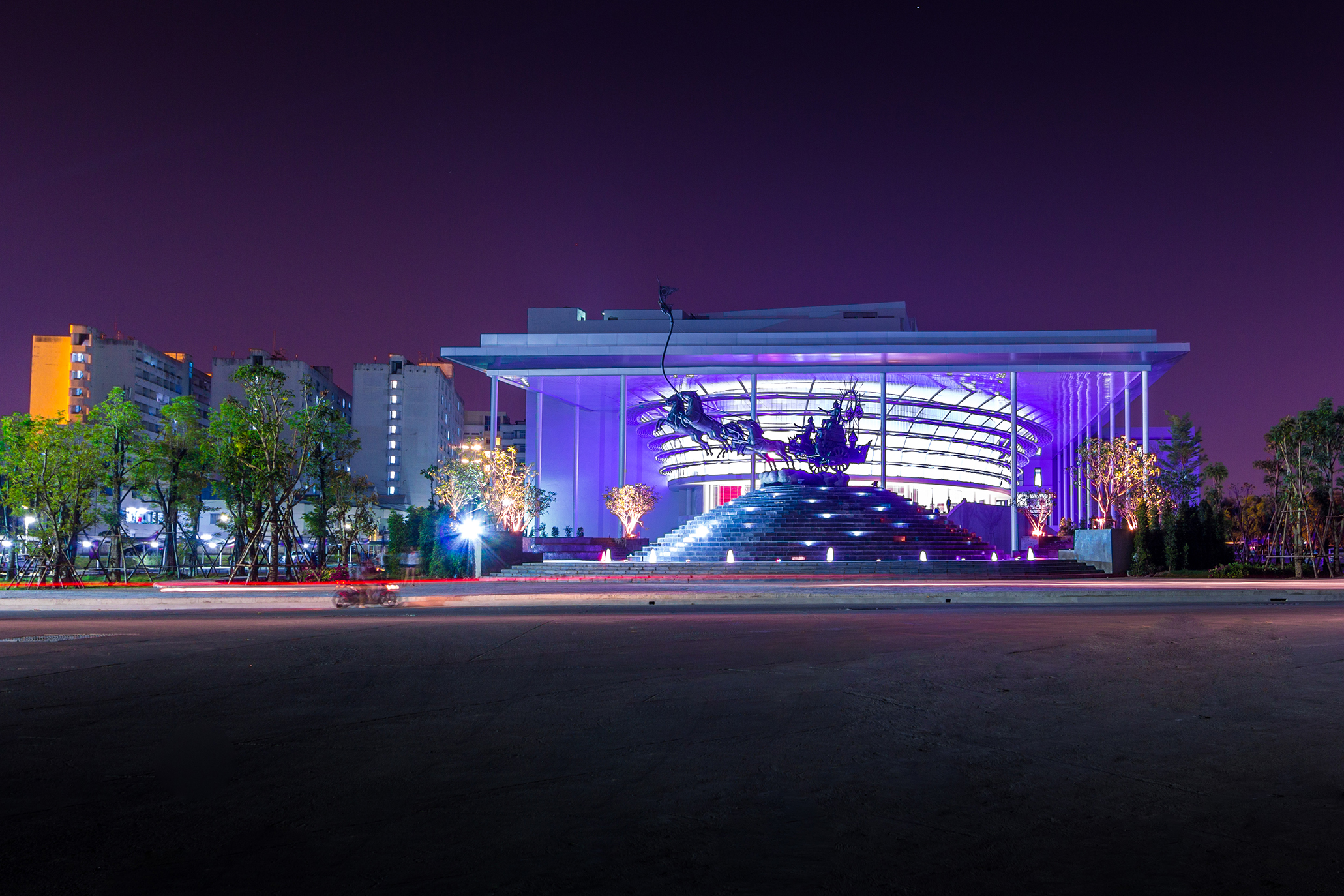
PHOTO: SOMPORN SAKKARA
ศาลาดนตรีสุริยเทพมหาวิทยาลัยรังสิต
SURYADHEP MUSIC SALA, RANGSIT UNIVERSITY
“I’ve always liked it. Writing poems. I had always been chosen to represent my school in literary competitions since I was in middle school. I wrote this poem from my own interpretation of what Dr. Arthit Ourairat, the owner of Rangsit University, was looking for. Once I used the poem to help get my idea across, what I wanted to present to him at the design presentation already found its way into his heart. What I did was turning architecture into something that is far more than just a visual representation. This work isn’t just an architectural creation but the construction of an identity. Through this built structure, the story of the university is expressed and users are able to relate to this particular building and space on a much more meaningful level.”
From a student in a gifted classroom at Suankularb Wittayalai School, the country’s leading school that has long produced generations of talented individuals for various disciplines and professions (mostly in sciences), Sunthareerat told us that his interest in Thai art and architecture started from the Thai Painting class he chose as one of his electives during his high school years. “The teacher of that class was Mr. Wisit Mueanjai. He was the first one who taught me all the basics of Thai pattern drawings. I saw him draw the Pud Tarn pattern and I was in awe, wanting to be able to draw like him. I think he picked that up, that I was in to this type of pattern drawing so he would always find pictures and images for me to practice with, and was instructing me on whose works I should study.” His keen interest in Thai Arts led Sunthareerat to spend most of his free time either practicing his drawing skills and tracing Thai patterns, or going to temples where he would draw, alone, in peace. When the time came for him to decide on his college education, unlike his classmates, Sunthareerat made up his mind and ended up getting himself a scholarship from the Thai Government’s Sathapatayanurak Project and landed himself a spot as a student in the Thai Architecture at Chulalongkorn University’s Faculty of Architecture.
“I thought I was pretty good because I was accepted with the highest entrance score. Before the entrance exam, I would practice my drawings with the painters who were working at Tri Thotsathep Temple. They were Thai painting painters who were the protégés of Chakrabhand Posayakrit, a national artist. I consider him to be one of my most important teachers because his work has had such a tremendous emotional and spiritual impact on me, even till this very day. When I was starting to really learn about Thai architecture during my first year of college, I got to learn from many architectural masters and everything was practically reset, including the mindset that I had.” Sunthareerat recalls that the first thing he encountered at the beginning of his architectural education was how Thai architecture was ‘expressed’ quite differently from Thai paintings. Even so, his experience as a university student has led him to become a ‘protégé’ of many Thai architectural masters, from the national artists such as Assoc. Prof. Dr. Pinyo Suwankiri, Air Vice Marshal Distinguished Scholar Arvuth Ngoenchuklin, and Pao Suwansaksri, to Professor Emeritus M.R. Nangnoi Saksri, the awarded Distinguished National Researcher who pioneered the study of the architecture of the Rattanakosin Era. The challenge of studying and practicing Thai architecture, which relies on a great deal of both the knowledge and skills, made him realize the extent of ‘unconditional love’ required to pursue this passion and career. It became a drive for him to make the knowledge and contributions of his teachers become, not only appreciated, but also free from the public’s neglect and insults.
Not long after he’d graduated, the Bureau of the Royal Household initiated a plan to construct the Borom Rajsathit Maholarn Throne Hall inside the Grand Palace. The Throne Hall would be used to accommodate a dinner that was attended by members of royal families as well as important figures from countries around the world as a part of the celebration of the sixtieth-anniversary celebrations of King Bhumibol Adulyadej’s accession to the throne. It was on this occasion that Sunthareerat was given the opportunity to be a part of the team responsible for the interior design of the Throne Hall. He remembers working extremely hard to show everyone that a student of Thai architecture could also execute western style interior design. After that project, Sunthareerat had a chance to work as an assistant for Korkiat Thongpud, one of the fine art masters of the Fine Arts Department (and the right-hand man of Air Vice Marshal Arvuth Ngoenchuklin). His job was to work on the detailed drawings of Devaranyasathan Royal Pavilion and the experience had allowed him to polish both his knowledge and skills in the practice of traditional Thai architecture.
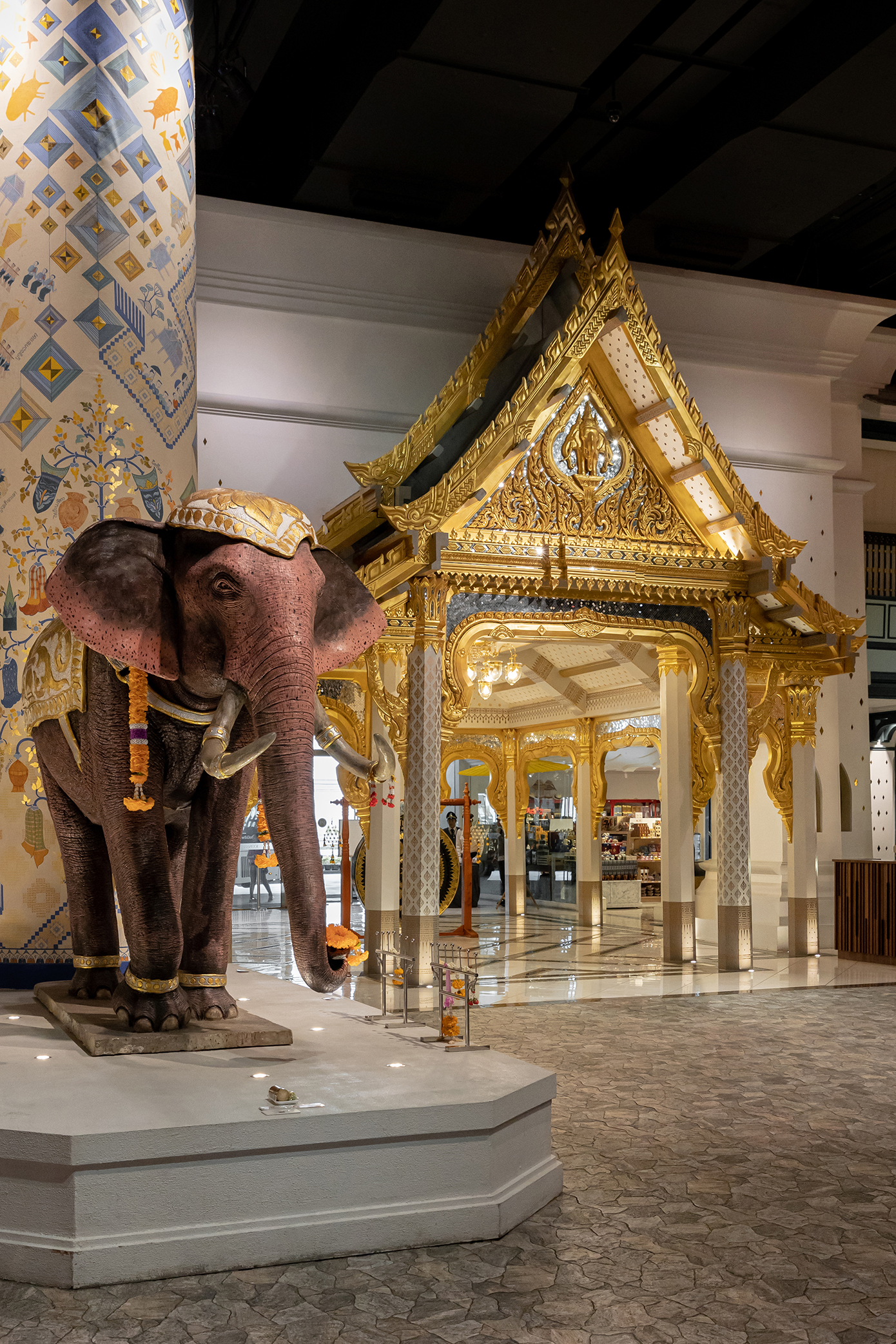
PHOTO: KETSIREE WONGWAN
ศาลาไทยทองคำภายในโครงการสุขสยาม (SOOKSIAM) ซึ่งเป็นส่วนหนึ่งของห้างสรรพสินค้า ICONSIAM
THAI GOLDEN PAVILION CREATED FOR ‘SOOKSIAM,’ A PROGRAM INSIDE THE ICONSIAM SHOPPING MALL
The big turning point in his life came when he received the Tadao Ando’s Scholarship. Sunthareerat, as the representative of Thailand, set off to Japan to deliver a presentation and participate in an internship program. Leaving his comfort zone to venture off to the outside world, and being exposed to Japanese culture that pays great respect to the skills and crafts of masterful artisans, Sunthareerat found himself greatly encouraged after feeling failed by the idea that Thai architecture would never be able to survive. “I think the strange thing about Thailand is that we often look down on the people who have this great knowledge in the country’s traditional arts and cultures. We’re living in the time when people now realize the value and level of complication involved in Thai arts and architecture. People have grown to accept that there’s something really cool about this type of work. But ten years ago, the insult was way worse. Japanese culture, on the other hand, thinks so highly of this particular genre of work. I remember feeling that I had never been given this much respect in my life. The experience really made me feel like I could really be proud of my skills again.”
One of the characteristics commonly found in Sunthareerat’s works is the way he plays with the elements of light and shadow with such great comprehension. He utilizes the architectural characteristic of Thai architecture in such an interesting manner, and naturally and confidently integrates the traditional to the modern. Sunthareerat continues to express his opinion on how modern architecture in Thailand rarely provides any space for Thai architecture to shine. One of his observations is the way Thai pavilions, if designed poorly, become nothing more than an object used as a part of the decoration of a garden or as a part of the landscape. For Thai architecture and modern architecture to converse with flair, the architect needs to know what should and should not be emphasized in the project. The structure of Suvarna Mondop Phra Sri Satsada Buddha Hall at Rangsit University situated in front of Pic-Ganesha Student Center is an interesting example of Sunthareerat’s thoughts and design process, which is reflected in the work’s elaborated details of Thai architecture, including the interplay between the effects of light and shadow. The design brings traditional Thai architecture back to play the role of the protagonist. “If you are able to understand how modern architecture functions and how a traditional architecture works, you will be able to bring to the two forms together,” said Sunthareerat.
The track record of his studio, Pillar Architects & Associates include religious buildings he worked on (some were for free, while for other projects, his fee depended on how much the owners could actually afford) for religious buildings in Thailand and foreign countries. The studio is also a part of the team responsible for the design of hospital buildings for various organizations (which would need another article to cover). One of Sunthareerat’s most recognized achievements is being on a cultural consultation team that created SOOKSIAM, a program inside ICONSIAM, the shopping mall that had recently won Best Store Design of the Year from World Retail Awards 2019. SOOKSIAM brings together works of Thai architecture from all regions of the country with Thai Golden Pavilion situated at the entrance as the highlight, a manifetation of the brilliant convergence of traditional craftsmanship skills and contemporary culture. The project showcases the abilities of architecture and interior design as key mechanisms that creates a unique user experience through the physicality of modern public spaces such as a shopping mall. “I grew up surrounded by the presence and influences of people with great craftsmanship. My mother was a hairdresser; my father’s a handyman. My grandfather used to dig up some tree roots, and he would bleach and carve them as a hobby. I believe that we were all born in a household with peoplewho possess some great set of skills. Innately, we are all craftsmen of some sort. It is up to us whether we will be able to come to terms with that ability and how far we can push it.”


